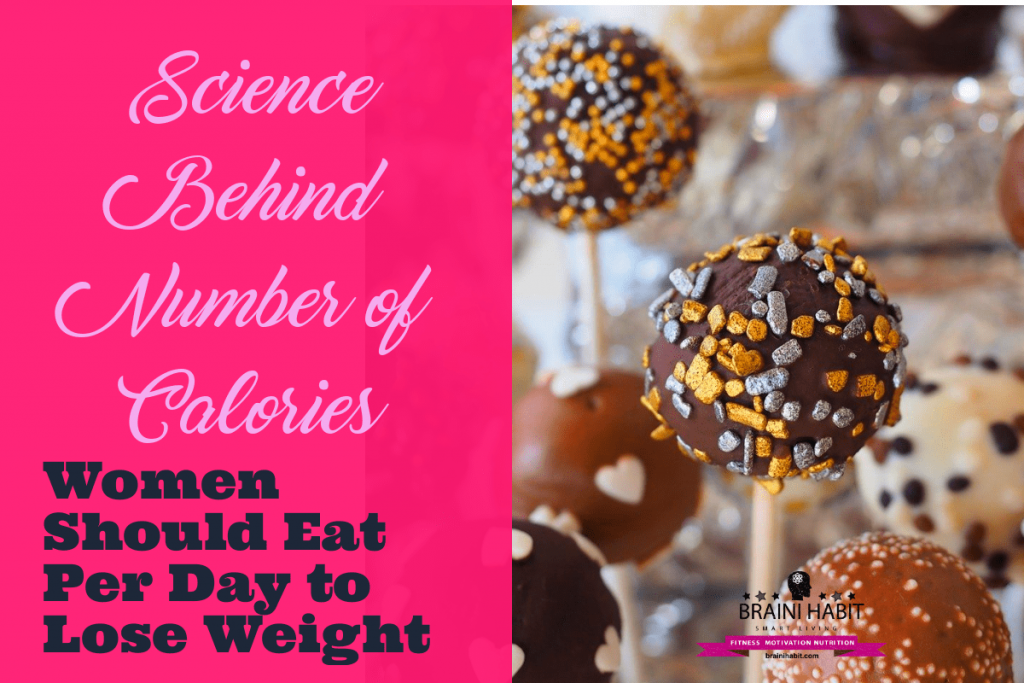When it comes to dieting and losing weight, a common topic is the one about calories.
Caloric balance is, in fact, the main factor that will determine if a diet is successful or not in terms of weight loss.
Even the diets that claim you can slim down without restricting calories, ultimately lead to a deficit in order to be effective.
In this article, we will explain thoroughly what exactly calories are and what is the number we need to lose weight.

- Calories in vs calories out
- Calorie expenditure and metabolism
- Are all calories created equal?
- What are the so-called empty calories?
- Having abs does not make you healthy
- The benefits of counting calories
- Sustainability of calorie counting
- IIFYM diet
- How many calories do you need?
- The take-home message on the science behind calories for women
Calories in vs calories out
According to science, the calorie balance is always the main contributor to weight changes (1).
It is impossible to lose weight unless you are in a caloric deficit. This means the calories you take in should be less than the calories you expend.
Similarly, studies show that being in a caloric surplus is what leads to weight gain and obesity (2).
Just like anything else in the universe, our body also obeys the law of conservation of energy which states that the total energy of an isolated system remains constant.
The human body is not an isolated system, which means we need to consume food, in order to compensate for the energy lost while interacting with the environment.
If the energy we consumed is in excess compared to the amount needed for the production of heat, metabolic processes, and physical activities, it will be stored for future use.
The way it is stored might be fat, or glycogen, or muscle.
And while whether we gain or lose weight will depend on calories alone, the type of tissue – fat or muscle gained or lost will depend on more factors, such as nutrient levels in our diet.
Diets and Calories
Many modern alternative diets try to promote that this or that type of food or nutrient can be more or less beneficial to lose weight.
However, this is not true. For example, low-carbohydrate diets that claim lower insulin levels will lead to better weight loss are disproven by science.
Evidence shows they hold no metabolic advantage compared to other diets, as long as the caloric deficit is the same (3).
Multiple studies comparing low-carbohydrate vs low-fat diets have shown no differences in weight loss if the deficit is matched (4, 5, 6, 7).
The only “advantage” might come from sufficient amounts of protein, due to it leading to better satiety and preserving muscle mass, but still without effect on fat loss (8, 9).
Take-Away:
The balance between calories taken in and calories burned is the main factor that determines whether an individual will gain or lose weight.
Calorie expenditure and metabolism
While the calories depend on our diet, the second part of the energy balance is much more complicated.
There are three main parts of your daily energy expenditure – basal metabolic rate, physical activity, and diet-induced energy expenditure (10).
The basal metabolic rate is the energy your body needs to maintain homeostasis, including the functions of different organs and body temperature.
It is also called resting energy expenditure.
It is determined by your body weight and composition, such as fat percentage, muscle mass, etc.
Physical activity is two main types – exercise activity thermogenesis and non-exercise activity thermogenesis.
While exercise activity is obvious, the non-exercise activity includes all your spontaneous movements, maintaining posture, etc.
And the last part is the diet-induced thermogenesis. This is the energy spent on digestion, transport, and storage of the food we consume.
It depends on the type of food – for example, protein is harder to digest, thus has a higher thermogenic index – the body burns slightly more calories (11, 12).
The main contributor to the overall metabolism comes from the basal metabolic rate – over 60%.
Metabolism and Calories
The main driver of it is the muscle mass and it plays a major role in our metabolism, yet few women pay close attention to their muscle mass.
It is true that organs like the brain, heart, liver, kidneys burn a lot of energy for their metabolism – 15-30 times more than muscle mass (estimates are for a pound of tissue) (13).
However, they are very small compared to the whole bodyweight – only 1-2%, so the percentage they contribute to the basal metabolic rate is also not high.
Muscle mass, however, makes up more than 30% of total body weight, even in untrained women, and it can also be increased with training (14).
It also burns almost 3 times more calories than fat tissue (yes, fat tissue contributes to burning calories as well to a lesser extent).
This is why muscle is the main driver of our metabolisms and we need to keep it, in order to burn more energy and maintain optimal weight more easily.
Take-Away:
Our caloric expenditure depends on 3 different factors – basal metabolic rate, thermogenic index of the food, and physical activity (both exercise and non-exercise).
Are all calories created equal?
The correct answer to this question depends on the context.
Calories are the units used to measure energy. When we measure the energy of the food, we use kilocalories.
1 kilocalorie is calculated as the amount of energy needed to raise the temperature of a liter of water by 1°C (1.8 °F) at one atmospheric pressure (15).
First of all, we have three main groups of nutrients which are sources of calories. They are also called macronutrients – proteins, carbohydrates, and fats (16).
A gram of each has a different caloric density:
- 1 gram protein ≈ 4 kcals
- 1 gram (g) carbohydrates ≈ 4 kcals
- 1g fat is about 9 kcals
These are not exact numbers since some types of nutrients might be harder to digest than others.
What is more, the body can transform one nutrient into another. For example, proteins can be used for the production of carbohydrates such as glucose.
On the other hand, carbohydrates can be used for the process of lipogenesis and turned into fatty acids.
However, there are also so-called essential nutrients. Proteins and fatty acids are essential nutrients, which we have to consume with the diet because we cannot produce them from other nutrients (17).
And while whether we gain or lose weight will depend on calories alone, the type of tissue – fat or muscle gained or lost will depend on more factors, such as the different ratios of macronutrients in our diet.
In order to lose fat instead of muscle and have optimal health, we will need balanced amounts of proteins, fats, and carbohydrates while staying in a caloric deficit.
Take-Away:
Although calorie is a calorie, different sources of calories have other functions apart from supplying the body with energy, which makes it crucial to have a well-balanced diet in terms of macro and micronutrients as well.
What are the so-called empty calories?
Everyone has seen or heard of empty calories, and that we should try to restrict them. But what exactly are they?
It is a collective term used for foods which contain calories from different macronutrients (usually non-essential) without containing any micronutrients such as vitamins, minerals, antioxidants, etc.
These foods often contain a lot of calories, so they are considered energy-dense. Such are different convenience foods, fast foods, fried foods, sugary foods and beverages, alcohol.
The process of frying, for example, can lead to a reduction in the levels of many vitamins and minerals.
On the other hand, we have foods that are rich in micronutrients as well, which we call nutrient-dense foods.
For example, fruits and vegetables, whole grains, dairy, meat, legumes, nuts, and seeds.
We should prefer nutrient-dense foods, instead of energy-dense ones, in order to supply our bodies with essential nutrients and improve our health.
Diets rich in micronutrients are linked to reduced incidence of diabetes and heart diseases, thus extending life expectancy (18, 19).
Take-Away:
Empty calories are foods which are energy-dense, but poor in essential macro and micronutrients.
Having abs does not make you healthy
Slimming down and becoming healthy is not always the same thing.
As we already mentioned, a caloric deficit is the only condition required for a successful weight loss. Losing weight has multiple health benefits.
Obesity is a huge risk factor for the leading causes of death worldwide – heart disease, diabetes, and cancer (20, 21, 22)
There is evidence suggesting that there might be a relationship between belly fat and Alzheimer’s (23).
However, being lean on an unhealthy diet, will not always lead to a completely healthy body.
A classic example is the vegan diet – it restricts all animal sources, which often leads to reduced caloric intake and weight loss.
However, only animal products contain an absorbable form of iron (24, 25).
This leads to the most common type of deficiencies – iron deficiency (26).
It results in anemia, a weak immune system, and disturbed cognition (27).
For cardiovascular health is critical to consume the right type and amount of fats (28).
Saturated and unsaturated fats have the same number of calories.
However, saturated fats (both animal and plant) should be restricted (<10% of daily calories), and hydrogenated (trans) fats should be completely avoided (29, 30).
Unsaturated fats should be preferred (mono or poly) but still total fats should be within reason – 20 to 30% of our daily caloric intake.
For instance, dietary fiber in combination with reducing the amount of saturated fats can help to prevent the most common type of cancer – colorectal cancer (31).
A lot of athletes with perfect physiques also have nutrient deficiencies, due to too restrictive dieting.
Studies involving professional athletes showed severe deficiencies in the amounts of vitamin D, calcium, magnesium, and zinc (32, 33).
Take-Away:
For optimal health, it is important to maintain optimal body weight but also to supply your body with the required macro and micronutrients, such as vitamins and minerals.
The benefits of counting calories
Counting the actual amount of calories you eat is the only way that you can be certain, what is your actual energy intake.
This is done by weighing your meals, listing them down and using calculators, to see the calorie content of each food.
There are many different and easy to use calorie counting apps for example.
It is beneficial even for a short time, as it allows people to find out their actual caloric intake.
Studies show that people who do not count their calories underestimate the amount they consume (34, 35).
Also, listing down your foods can help you see unhealthy habits, which can help you make the necessary changes for a successful long-term weight loss.
Such unhealthy dietary choices might be many calorie-dense foods, sources of empty calories, junk, mid-night snacking, etc.
Also, we can see which foods make us more or less satiated.
Satiation is one of the main aspects of successful dieting and achieving long-term weight control.
Take-Away:
Counting calories can be beneficial for the short term as it can help you identify bad dietary habits and gain insight into the nutritional value of most foods.
Sustainability of calorie counting
However, counting calories, just like any other regime, is not for everyone – many people can become obsessed.
At some point, counting calories becomes more important than the actual choice of food.
They start using it as an excuse to eat mostly unhealthy food, as long as they fit into their caloric goals.
Others can restrict themselves too much, which affects them on a psychological level. As a result, they become much more likely to binge eat.
According to studies, counting calories can trigger obsessive-compulsive behavior and become a source of an eating disorder (36).
For most people counting calories is simply too demanding, stressful or consumes too much time.
This is why counting calories is generally not sustainable for everyone in the long-term.
This can be a huge downside, as studies show that sustainability is the second major factor after caloric deficit, in order to achieve and maintain optimal weight (37).
Tips to help you stay in a caloric deficiency:
- Eat more mindfully – avoid distractions and stop eating when feeling full, don’t let yourself overeat – overeating will get you very quickly in a caloric surplus.
- Use smaller plates
- Try to skip the dessert, add it only to a meal after intensive physical activity
- Drinking more water before meals can help create volume and satiation faster.
- Plan your meals to avoid too many snacks and last-minute solutions which might be unhealthy
- Eat around a schedule! That way you will get hungry at the same time every day
- Eating protein in every meal – helps you maintain the feeling of fullness on lower caloric intake
- Eat more non-starchy vegetables – fiber in vegetables also provides great satiation. The recommendation is at least 400g of fresh fruits and vegetables daily
- Avoid liquid foods with calories – they provide no satiation and you can very easily overeat on high sugar and calories they contain
- Avoid eating junk foods – usually, those are foods high in sugar, saturated fats, and calories
- Although they are healthy, foods like oils, nuts, and honey are very caloric and not suitable to lose weight (38).
Take-Away:
Calorie counting might not be sustainable for everyone, due to multiple factors, including social and psychological individual traits.
IIFYM diet
This is a type of diet in which the IIFYM abbreviation stands for “if it fits your macronutrients”. It is also known as flexible dieting.
It is a weight loss diet that is entirely based on the principle calories in vs calories out, and macronutrient balance.
Since the total sum of your macronutrients makes up your calorie intake, the diet allows you to eat everything as long as it is within your macronutrient and caloric needs.
The first step of following the diet includes calculating your macronutrient and energy needs.
This way you determine how many grams of proteins, fats, and carbohydrates your body needs every day.
You have to calculate your basal metabolic rate first, and take into account additional energy spent on your daily physical activities.
The most widely used formula is the Mifflin-St. Jeor equation, which is proven to be accurate by studies (39, 40).
Afterward, reduce your calorie intake by 10-20% of your calorie expenditure, in order to lose weight.
Your macronutrients should be as follows:
- 15-25% of your energy intake should come from protein
- 20-30% from fat
- 45-65% from carbohydrates
Once you know your macronutrients you need to track the food you eat and stay within limits.
Evidence suggests that tracking food is an effective method in achieving successful weight management (41).
Another study shows that food tracking in the form of food apps and other computerized methods is also an effective method for self-monitoring and leads to greater weight loss (42).
Being a more flexible and less restrictive diet in terms of dietary choices makes it a more enjoyable experience for the people following it (43).
Take-Away:
IIFYM is a diet mainly focused around eating certain amounts of calories in macronutrients in order to achieve your goals.
How many calories do you need?
On average a woman needs 1500-2000 kcals to achieve optimal weight, while an average man needs 2500 kcals or more.
However, there are multiple individual factors, included in the Mifflin-St. Jeor equation such as age, height, current weight, and activity levels.
These factors can lead to huge variations amongst individuals so it is best if you calculate it for yourself, before making any assumptions.
One of the biggest variations comes from physical activity levels, which does not include just walking or participating in sports, but also non-exercise daily activities, such as maintaining posture, fidgeting, etc.
For example, a study involving 16 participants showed that different people react with different changes in that non-exercise activity and some can compensate for a 1000 caloric surplus with almost 70% (44).
What about when you eat all your calories for the day but you are still hungry?
Avoiding such situations is another reason to care about your dietary choices, and do not fit only junk food in your macronutrient limits.
Whole foods are much more satiating compared to fast-foods and similar products. Consider that 200 kcals can come from 40grams of potato chips, 400 grams of apples, or over a kilogram of cucumbers.
The most satiating foods are the ones rich in protein and fiber.
Many types of meat, vegetables, and fruits are ranked quite high in the satiation index of common foods (45).
Of course, green and leafy vegetables are also very helpful as they increase the total volume of food consumed without having any calories at all.
Take-Away:
There are significant variability in the number of calories for different people in order to maintain optimal weight. They depend on body size traits as well as activity level.
The take-home message on the science behind calories for women
The balance between calories in and calories out is always going to be the single most important factor for weight change.
Every diet that has led to a successful loss of weight has caused a caloric deficit in one way or another.
However, when it comes to health, the effect of the diet goes beyond the number of calories.
The improper ratio or deficiency of macro and micronutrients can have a detrimental effect on overall health and lead to diseases.
Also, the ratio of macronutrients will determine if the majority of the weight we lose is going to be fat or muscle.
This is why it is important to remember that to lose weight successfully does not exclude the well balanced and healthy nutrition as a requirement for optimal well-being.





